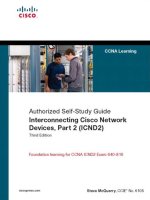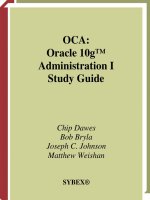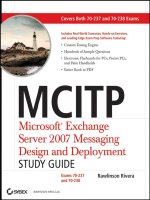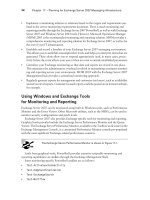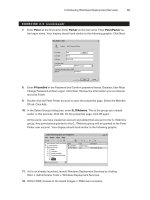cisco voice over ip cvoice authorized self study guide phần 1 pptx
Bạn đang xem bản rút gọn của tài liệu. Xem và tải ngay bản đầy đủ của tài liệu tại đây (376.56 KB, 10 trang )
Authorized Self-Study Guide
Cisco Voice over IP (CVOICE),
Third Edition
Kevin Wallace
Copyright© 2009 Cisco Systems, Inc.
Published by:
Cisco Press
800 East 96th Street
Indianapolis, IN 46240 USA
All rights reserved. No part of this book may be reproduced or transmitted in any form or by any means,
electronic or mechanical, including photocopying, recording, or by any information storage and retrieval
system, without written permission from the publisher, except for the inclusion of brief quotations in a
review.
Printed in the United States of America
First Printing July 2008
Library of Congress Cataloging-in-Publication Data:
Wallace, Kevin, CCNP.
Authorized self-study guide : Cisco Voice over IP (CVoice) / Kevin Wallace. — 3rd ed.
p. cm.
ISBN 978-1-58705-554-6 (hbk. : CD-ROM) 1. Internet telephony—Examinations—Study guides. 2.
Electronic data processing personnel—Certification—Study guides. I. Title. II. Title: Cisco Voice over IP
(CVoice).
TK5105.8865.W3345 2008
004.69’5—dc22
2008022672
ISBN-13: 978-1-58705-554-6
ISBN-10: 1-58705-554-6
Warning and Disclaimer
This book is designed to provide information about the Cisco Voice over IP (CVOICE) certification
topics. Every effort has been made to make this book as complete and as accurate as possible, but no
warranty or fitness is implied.
The information is provided on an “as is” basis. The authors, Cisco Press, and Cisco Systems, Inc., shall
have neither liability nor responsibility to any person or entity with respect to any loss or damages arising
from the information contained in this book or from the use of the discs or programs that may
accompany it.
The opinions expressed in this book belong to the author and are not necessarily those of Cisco
Systems, Inc.
ii Authorized Self-Study Guide: Cisco Voice over IP (CVOICE)
Foreword
Cisco certification Self-Study Guides are excellent self-study resources for networking pro-
fessionals to maintain and increase internetworking skills and to prepare for Cisco Career
Certification exams. Cisco Career Certifications are recognized worldwide and provide
valuable, measurable rewards to networking professionals and their employers.
Cisco Press exam certification guides and preparation materials offer exceptional—and
flexible—access to the knowledge and information required to stay current in one’s field of
expertise or to gain new skills. Whether used to increase internetworking skills or as a sup-
plement to a formal certification preparation course, these materials offer networking pro-
fessionals the information and knowledge required to perform on-the-job tasks proficiently.
Developed in conjunction with the Cisco certifications and training team, Cisco Press
books are the only self-study books authorized by Cisco, and they offer students a series of
exam practice tools and resource materials to help ensure that learners fully grasp the con-
cepts and information presented.
Additional authorized Cisco instructor-led courses, e-learning, labs, and simulations are
available exclusively from Cisco Learning Solutions Partners worldwide. To learn more,
visit
I hope you will find this guide to be an essential part of your exam preparation and profes-
sional development, as well as a valuable addition to your personal library.
Drew Rosen
Manager, Learning & Development
Learning@Cisco
June 2008
xviii Authorized Self-Study Guide: Cisco Voice over IP (CVOICE)
Introduction
With the rapid adoption of Voice over IP (VoIP), many telephony and data network techni-
cians, engineers, and designers are now working to become proficient in VoIP. Professional
certifications, such as the Cisco Certified Voice Professional (CCVP) certification, offer
validation of an employee’s or a consultant’s competency in specific technical areas.
This book mirrors the level of detail found in the Cisco CVOICE Version 6.0 course, which
many CCVP candidates select as their first course in the CCVP track. Version 6.0 repre-
sents a significant update over Version 5.0 of the CVOICE course, because Version 6.0
integrates much of the content previously found in the more advanced Implementing Cisco
Voice Gateways and Gatekeepers (GWGK) course.
A fundamental understanding of traditional telephony, however, would certainly benefit a
CVOICE student or a reader of this book. If you think you lack a fundamental understand-
ing of traditional telephony, a recommended companion for this book is the Cisco Press
Voice over IP First-Step book (ISBN: 978-1-58720-156-1), which is also written by this
book’s author. Voice over IP First-Step is written in a conversational tone and teaches con-
cepts surrounding traditional telephony and how those concepts translate into a VoIP envi-
ronment.
Additional Study Resources
This book contains a CD with approximately 90 minutes of video, where you will see the
author demonstrate a variety of basic VoIP configurations. The videos were originally
developed for NetMaster Class (), a company specializing
in CCIE Lab training. These video-on-demand titles are as follows:
Analog Voice Port Configuration
Digital Voice Port Configuration
Dial Peer Configuration
H.323 Configuration
MGCP Configuration
SIP Configuration
As an additional reference for readers pursuing the CCVP certification, the author has cre-
ated a website with recommended study resources (some free and some recommended for
purchase) for all courses in the CCVP track. These recommendations can be found at the
following URL: .
xix
Goals and Methods
The primary objective of this book is to help the reader pass the 642-436 CVOICE exam,
which is a required exam for the CCVP certification and for the Cisco Rich Media
Communications Specialist specialization.
One key methodology used in this book is to help you discover the exam topics that you
need to review in more depth, to help you fully understand and remember those details,
and to help you prove to yourself that you have retained your knowledge of those topics.
This book does not try to help you pass by memorization, but helps you truly learn and
understand the topics by using the following methods:
■
Helping you discover which test topics you have not mastered
■
Providing explanations and information to fill in your knowledge gaps, including
detailed illustrations and topologies as well as sample configurations
■
Providing exam practice questions to confirm your understanding of core concepts
Who Should Read This Book?
This book is primarily targeted toward candidates of the CVOICE exam. However, because
CVOICE is one of the Cisco foundational VoIP courses, this book also serves as a VoIP
primer to noncertification readers.
Many Cisco resellers actively encourage their employees to attain Cisco certifications and
seek new employees already possessing Cisco certifications, for deeper discounts when
purchasing Cisco products. Additionally, having attained a certification communicates to
your employer or customer that you are serious about your craft and have not simply
“hung out a shingle” declaring yourself knowledgeable about VoIP. Rather, you have
proven your competency through a rigorous series of exams.
How This Book Is Organized
Although the chapters in this book could be read sequentially, the organization allows you
to focus your reading on specific topics of interest. For example, if you already possess a
strong VoIP background, you could skim the first two chapters (which cover foundational
VoIP topics, including an introduction to VoIP and elements of a VoIP network) and focus
on the remaining seven chapters, which address more advanced VoIP concepts.
Specifically, the chapters in this book cover the following topics:
Chapter 1, “Introducing Voice over IP Networks”: This chapter describes VoIP, compo-
nents of a VoIP network, the protocols used, and service considerations of integrating VoIP
xx Authorized Self-Study Guide: Cisco Voice over IP (CVOICE)
into an existing data network. Also, this chapter considers various types of voice gateways
and how to use gateways in different IP telephony environments.
Chapter 2, “Considering VoIP Design Elements”: This chapter describes the challenges
of integrating a voice and data network and explains solutions for avoiding problems when
designing a VoIP network for optimal voice quality. Also, you learn the characteristics of
voice codecs and digital signal processors and how to perform bandwidth calculations for
VoIP calls.
Chapter 3, “Routing Calls over Analog Voice Ports”: This chapter describes the various
call types in a VoIP network. You then learn how to configure analog voice interfaces as
new devices are introduced into the voice path. Finally, you discover how to configure dial
peers, in order to add call routing intelligence to a router.
Chapter 4, “Performing Call Signaling over Digital Voice Ports”: This chapter
describes various digital interfaces and how to configure them. Also, you are introduced to
Q Signaling (QSIG) and learn how to enable QSIG support.
Chapter 5, “Examining VoIP Gateways and Gateway Control Protocols”: This chapter
details the H.323, MGCP, and SIP protocol stacks, and you learn how to implement each
of these protocols on Cisco IOS gateways.
Chapter 6, “Identifying Dial Plan Characteristics”: This chapter describes the compo-
nents and requirements of a dial plan and discusses how to implement a numbering plan
using Cisco IOS gateways.
Chapter 7, “Configuring Advanced Dial Plans”: This chapter shows you how to config-
ure various digit manipulation strategies using Cisco IOS gateways. Additionally, you learn
how to influence path selection. This chapter then concludes with a discussion of the Class
of Restriction (COR) feature, and you learn how to implement COR on Cisco IOS gate-
ways to specify calling privileges.
Chapter 8, “Configuring H.323 Gatekeepers”: This chapter describes the function of a
Cisco IOS gatekeeper. Also, you learn how to configure a gatekeeper for functions such as
registration, address resolution, call routing, and call admission control (CAC).
Chapter 9, “Establishing a Connection with an Internet Telephony Service Provider”:
This chapter describes Cisco Unified Border Element (Cisco UBE) functions and features.
You learn how a Cisco UBE is used in current enterprise environments and how to imple-
ment a Cisco UBE router to provide protocol interworking.
xxi
After reading this chapter, you should be able to perform
the following tasks:
■ Describe the various call types in a VoIP network.
■ Configure analog voice interfaces as new devices are
introduced into the voice path.
■ Configure dial peers so you can add call routing
intelligence to a router.
Voice gateways bridge the gap between the VoIP world and the traditional telephony world
(for example, a private branch exchange [PBX], the public switched telephone network
{PSTN], or an analog phone). Cisco voice gateways connect to traditional telephony devices
via voice ports. This chapter introduces basic configuration of analog and digital voice ports
and demonstrates how to fine-tune voice ports with port-specific configurations. Upon
completing this chapter, you will be able to configure voice interfaces on Cisco voice-
enabled equipment for connection to traditional, nonpacketized telephony equipment.
Introducing Analog Voice Applications on Cisco IOS
Routers
Before delving into the specific syntax of configuring voice ports, this section considers
several examples of voice applications. The applications discussed help illustrate the
function of the voice ports, whose configuration is addressed in the next section.
Different types of applications require specific types of ports. In many instances, the
type of port is dependent on the voice device connected to the network. Different types
of voice applications include the following:
■ Local calls
■ On-net calls
■ Off-net calls
■ Private line, automatic ringdown (PLAR) calls
■ PBX-to-PBX calls
■ Intercluster trunk calls
■ On-net to off-net calls
The following sections discuss each in detail and provide an example.
Local Calls
Local calls, as illustrated in Figure 3-1, occur between two telephones connected to one
Cisco voice-enabled router. This type of call is handled entirely by the router and does
not travel over an external network. Both telephones are directly connected to Foreign
Exchange Station (FXS) ports on the router.
CHAPTER 3
Routing Calls over Analog Voice
Ports
126 Authorized Self-Study Guide: Cisco Voice over IP (CVOICE)
V V
PBX
Gateway Gateway
Dial:
“555-0188”
555-0188
IP WAN
Ring!!
Figure 3-1 Local Calls
An example of a local call is one staff member calling another staff member at the same
office. This call is switched between two ports on the same voice-enabled router.
On-Net Calls
On-net calls occur between two telephones on the same data network, as shown in
Figure 3-2. The calls can be routed through one or more Cisco voice-enabled routers, but
the calls remain on the same data network. The edge telephones attach to the network
through FXS ports or through a PBX, which typically connects to the network via a T1
connection. IP phones that connect to the network via switches place on-net calls
through Cisco Unified Communications Manager. The connection across the data net-
work can be a LAN connection, as in a campus environment, or a WAN connection, as in
an enterprise environment.
V V
PBX
Gateway Gateway
San JoseAustin
Dial:
“555-0123”
555-0123
Ring!!
IP WAN
PSTN
Toll-Bypass
Ring!!
Figure 3-2 On-Net Calls
An example of an on-net call is one staff member calling another staff member at a remote
office. The call is sent from the local voice-enabled router, across the IP network, and termi-
nated on the remote office voice-enabled router.
Off-Net Calls
Figure 3-3 shows an example of an off-net call. To gain access to the PSTN, the user dials
an access code, such as 9, from a telephone directly connected to a Cisco voice-enabled
router or PBX. The connection to the PSTN is typically a single analog connection via a
Foreign Exchange Office (FXO) port or a digital T1 or E1 connection.
Chapter 3: Routing Calls over Analog Voice Ports 127
Note The act of routing voice data across the WAN instead of the PSTN is known as
toll-bypass. Originally, companies saved significant amounts of money using this strategy,
which was one of the first major business benefits of a VoIP-enabled network.
V
Gateway
Dial Access
Code: “9”
Ring!!
PSTN
Figure 3-3 Off-Net Calls
An example of an off-net call is a staff member calling a client who is located in the same
city. The call is sent from the local voice-enabled router that is acting as a gateway to the
PSTN. The call is then sent to the PSTN for call termination.
PLAR Calls
PLAR calls automatically connect a telephone to a second telephone when the first tele-
phone goes off hook, as depicted in Figure 3-4. When this connection occurs, the user
does not get a dial tone, because the voice-enabled port that the telephone is connected
to is preconfigured with a specific number to dial. A PLAR connection can work
between any type of signaling, including E&M, FXO, FXS, or any combination of ana-
log and digital interfaces. For example, you might have encountered a PLAR connection
at an airline ticket counter where you pick up a handset and are immediately connected
with an airline representative.

